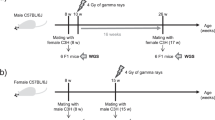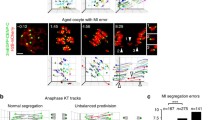Abstract
BECAUSE chromosomal trisomy is found with relatively high frequencies in congenital malformations and spontaneous abortions in man, the aetiology of abnormal segregation is a pressing problem. One possible factor is exposure of women to diagnostic X rays1–8. Experiments with Drosophila melanogaster indicate that nondisjunction can be induced by exposure of females to X rays9,10 especially if the flies are old11,12. Russell13 reported an increase in induced monosomy in mice by examining the progeny of matings with sex-linked markers. But many aneuploids may be lethal and the dosages used by Russell were large enough to cause loss of chromosomes by breakage. Recent advances in the technique of culturing mouse oocytes in vitro (ref. 14, modified by E. P. Evans and C. E. Ford) have made it possible to circumvent these difficulties by examining meiotic chromosomes in second metaphase. The following experiment was designed to examine the effect of low doses of whole-body irradiation on chromosome segregation during first meiotic division in the oocytes of young female mice.
Similar content being viewed by others
References
Uchida, I. A., and Curtis, E. J., Lancet, ii, 848–850 (1961).
Schull, W. J., and Neel, J. V., Lancet, i, 537–538 (1962).
Sigler, T. T., Lilienfeld, A. M., Cohen, A. M., and Westlake, J. E., Bull. Johns Hopkins Hosp., 117, 374–399 (1965).
Uchida, I. A., Holunga, R., and Lawler, C., Lancet, ii, 1045–1049 (1968).
Marmol, J. G., Scriggins, A. L., and Vollman, R. F., Am. J. Obstet Gynec., 104, 533–543 (1969).
Villumsen, A. L., Environmental factors in congenital malformations (F.A.D.L.s Forlag, København, Arhus, Odense, 1970).
Stevenson, A. C., Mason, R., and Edwards, K. D., Lancet, ii, 1335–1337 (1970).
Alberman, E., Polani, P. E., Fraser Roberts, J. A., Spicer, C. C., Elliott, M., and Armstrong, E., Ann. Hum. Genet., 36, 195–208 (1972).
Mavor, J. W., J. exp. Zool., 39, 381–432 (1924).
Traut, H., Mutat. Res., 1, 157–162 (1964).
Patterson, J. T., Brewster, W., and Winchester, A. M., J. Hered., 23, 325–333 (1932).
Uchida, I. A., Can. J. Genet. Cytol., 4, 402–408 (1962).
Russell, L. B., Science, 133, 1795–1803 (1961).
Tarkowski, A. K., Cytogenetics, 5, 394–400 (1966).
Röhrborn, G., Humangenetik, 16, 123–125 (1972).
Yamamoto, M., Shimada, T., Endo, A., and Watanabe, G., Nature new Biol., 244, 206–208 (1973).
Hamilton, H. D., Awa, A. A., Sofuni, T., Neriishi, S., and Honda, T., Fourth Int. Conf. Birth Defects Abstracts (Vienna, 1973).
Author information
Authors and Affiliations
Rights and permissions
About this article
Cite this article
UCHIDA, I., LEE, C. Radiation-induced nondisjunction in mouse oocytes. Nature 250, 601–602 (1974). https://doi.org/10.1038/250601a0
Received:
Revised:
Issue Date:
DOI: https://doi.org/10.1038/250601a0
- Springer Nature Limited
This article is cited by
-
A light- and electron microscopic analysis of meiotic prophase in female mice
Chromosoma (1983)
-
Nondisjunction and chromosome breakage in mouse oocytes after various X-ray doses
Human Genetics (1982)
-
Spontaneous meiotic non-disjunction in mammals. A study evaluating the various experimental approaches
Genetica (1981)
-
Aneuploidy in mouse fetuses after paternal exposure to X rays
Nature (1979)
-
Radiation-induced nondisjunction in oocytes of aged mice
Nature (1977)





